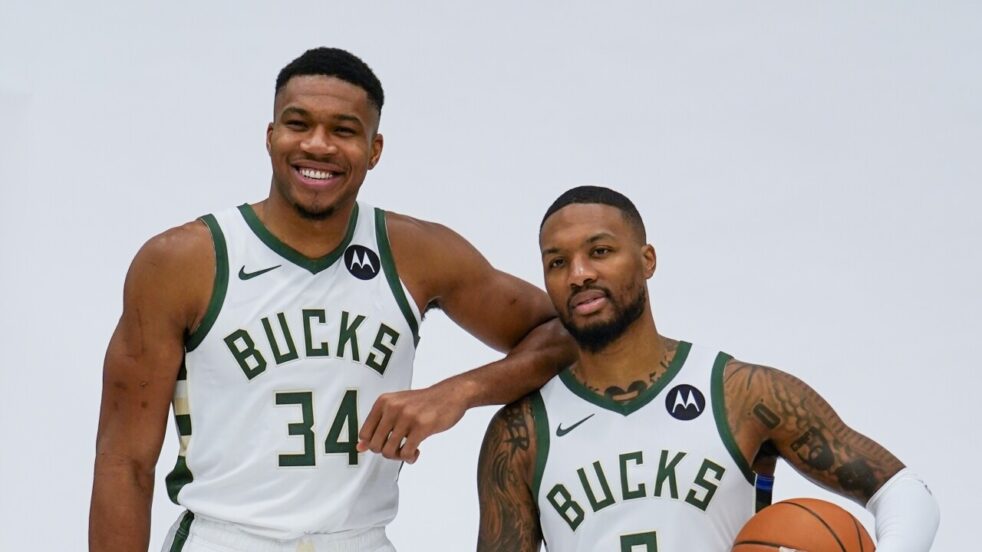The NBA off-season prior to the upcoming 2023-23 season was defined by two names: James Harden and Damian Lillard.
Lillard, the stalwart point guard of the Portland Trail Blazers, was traded to the Milwaukee Bucks on Sept. 27. It is one of the biggest superstar moves of the past few years, considering the 33-year old Lillard averaged a career high 32.2 points and 7.3 assists on an efficient 46% shooting from the field and 37% shooting from the three-point line in 2022-23.
James Harden, the starting shooting guard for the Philadelphia 76ers, is no stranger to trade requests. Back in 2021, he requested to leave the Houston Rockets, after leading the NBA in scoring the season prior, and joined the Brooklyn Nets to team up with the superstar duo of forward Kevin Durant and guard Kyrie Irving. When the situation in Brooklyn became unsatisfactory, he demanded out of Brooklyn and joined the Sixers. Now, his desire for a new contract and Philly’s refusal to give him one prompted his third trade request in as many years and fueled talk about his new destination.
The NBA and the NBA Player’s Association recently agreed to a new collective bargaining agreement (CBA) that has important consequences for player finances. This agreement sets the hefty rules for labour pay in the NBA and mandates several important rules, but the one most pertinent to rebuilding teams is the elimination of cap space aggregation.
All 30 NBA teams are subject to a salary cap that sets the spending parameters for the roster. There is a salary cap maximum of $136 million, but rebuilding teams are more worried about the cap floor of $122 million. Rebuilding teams often populate their rosters with young players on rookie-scale contracts or inexpensive veterans. This keeps cap space open for two reasons — paying the talent that they acquire through the rebuild and acquiring picks from more talented teams. Before the new CBA, rebuilding teams just held onto their cap space and acquired salary — if necessary — to reach $122 million by the end of the season. Under the new CBA, this practice will be significantly curtailed because teams are required to spend up to the cap floor by the start of the season.
Furthermore, teams will not be able to enter a rebuild with a bounty of high picks. That is because of the “second tax apron” — teams are allowed to spend over the salary cap maximum, but spending more than $17.5 million over it would limit their methods of player acquisition to re-signing homegrown players, signing draft picks and picking up veterans on minimum deals. Therefore, draft picks become incredibly valuable because it is a way to collect high- level talent while staying below the second apron statutes.
After getting rid of all their high-priced veterans from the Harden era, the Rockets went through two seasons at the bottom of the Western Conference and used high draft picks. As a re- sult, they had $60 million in 2023 cap space and splurged in free agency. Portland will not be able to go on a similar spending spree. Having that much cap space is go- ing to become more rare because teams need to hit the salary floor earlier and will accumulate larger salaries even if they are far away from a championship season.
The NBA is essentially forcing teams to maintain a competitive roster while rebuilding. Contending teams are going to have to be very careful with who they
give contracts to. If they make the wrong move, they will not have the luxury of undoing their move in a salary-dump trade to a rebuilding team. Therefore, Portland will not be able to clear cap space like Houston will.
However, Portland is poised to take advantage of other rules in the new CBA. For example, teams can retain young talent after their rookie deals run out on five-year, non-max contracts when non-max contract players were previously limited to four-year deals. If the Trail Blazers have a young player who does not qualify for a maximum extension, they can compete with offers from more competitive teams. Portland will also likely place an emphasis on their second-round draft picks. Teams will now be looking to build their rotation at a discount with good second-round talent because the new CBA creates an exception in the salary cap where second round picks can be rewarded for their performance at little cost.
While all the focus is on the winner of the Larry O’Brien Championship Trophy, it is equally important to track how those teams were built. Teams like Portland and Houston are entering uncharted territory — it will be fascinating to see if they can get back to the top of the league.
